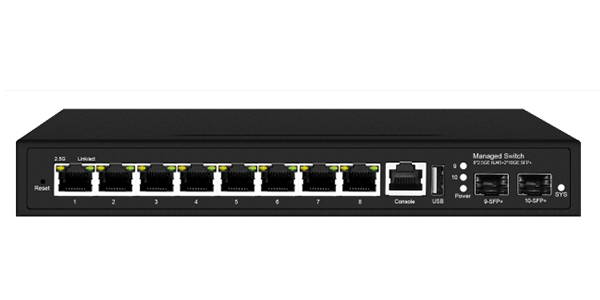ETH Switch & Industrial Switch

L3 MANAGED SWITCH
support high-speed Ethernet ports, including Gigabit Ethernet and 10~128 Gigabit Ethernet,

support high-speed Ethernet ports, including Gigabit Ethernet and 10~128 Gigabit Ethernet,
 Gigabit SFP & Electrical Hybrid
Gigabit SFP & Electrical Hybrid L3 Managed Switch
L3 Managed Switch PoE & Non-PoE Ports
PoE & Non-PoE Ports VLAN & WEB & CLI & SNMP
VLAN & WEB & CLI & SNMPAt the heart of Synway's L3 managed switches lies their routing functionality. Synway's switches can analyze and process data packets based on IP addresses, enabling them to route traffic between different subnets and virtual local area networks (VLANs) within a network. This feature eliminates the need for separate routers in many scenarios, streamlining network architecture and reducing costs. Synway's L3 switch can efficiently direct data traffic between various subnets, ensuring seamless communication between different parts of the organization


One of the defining features of Synway's L3 managed switches is their extensive management capabilities. They offer a user-friendly web-based graphical interface (GUI), command-line interface (CLI), and support for Simple Network Management Protocol (SNMP). Through the GUI, network administrators can easily configure and monitor various switch settings, such as VLANs, Quality of Service (QoS), port security, and traffic statistics, without the need for in-depth technical knowledge. The CLI can also provide more granular control for experienced administrators, allowing them to execute complex commands and scripts for advanced configuration.
One of the defining features of Synway's L3 managed switches is their extensive management capabilities. They offer a user-friendly web-based graphical interface (GUI), command-line interface (CLI), and support for Simple Network Management Protocol (SNMP). Through the GUI, network administrators can easily configure and monitor various switch settings, such as VLANs, Quality of Service (QoS), port security, and traffic statistics, without the need for in-depth technical knowledge. The CLI can also provide more granular control for experienced administrators, allowing them to execute complex commands and scripts for advanced configuration.

 Get A Free Sample
Get A Free Sample
 Products Inquiry
Products Inquiry
 Sales Consultancy
Sales Consultancy
 Specialist Channel
Specialist Channel
|
Software Specification: |
|
|
Category |
Feature Description |
|
Protocol Standards |
IEEE 802.3x, IEEE 802.3, IEEE 802.3u, IEEE 802.3ab, IEEE 802.3z, IEEE 802.3ad IEEE 802.1Q, IEEE 802.1p, IEEE 802.3q, IEEE 802.1w, IEEE 802.1d, IEEE 802.1s |
|
MAC Address Table |
Supports 16K MAC address table, automatic updating, bidirectional learning |
|
VLAN Configuration |
Port-based VLAN, up to 4096 VLANs, supports IEEE 802.1Q, voice VLAN with QoS |
|
Spanning Tree |
Supports STP, RSTP, MSTP, EPPS ring protocol, EAPS, IEEE 802.1x authentication |
|
Port Aggregation |
Supports 8 groups, up to 8 ports per group |
|
Port Mirroring |
Supports bidirectional (Rx & Tx) port mirroring |
|
Loop Protection |
Real-time detection, alarm, location, intelligent blocking, automatic recovery |
|
Port Isolation |
Downlink port isolation with uplink communication supported |
|
Port Flow Control |
Half-duplex: Backpressure-based; Full-duplex: PAUSE frame-based |
|
Port Rate Limiting |
Port-based input/output bandwidth management |
|
Multicast Control |
IGMP v1/v2/v3, MLD v1/v2 Snooping, GMRP, multicast VLAN, multicast address management Multicast routing ports, static multicast address configuration |
|
DHCP |
Supports DHCP Snooping |
|
Storm Suppression |
Suppresses unknown unicast, multicast, broadcast storms using bandwidth tuning & filters |
|
Security |
IP + MAC + port binding, ACLs based on IP/MAC, port-based MAC address security |
|
QoS |
IEEE 802.1p queue priority, CoS/ToS tagging, WRR, SP, WFQ scheduling algorithms |
|
Cable Detection |
Supports Auto-MDIX (auto-detects straight/crossover cables) |
|
Auto Negotiation |
Supports auto-negotiation for speed and duplex mode |
|
System Maintenance |
Firmware upgrade, system log, web-based factory reset |
|
PoE Management |
Port PoE on/off control, scheduling, auto device detection (no manual action required) |
|
Network Management |
Web GUI, CLI via Telnet/Console, SNMP v1/v2/v3, SSH v1/v2, RMON |


